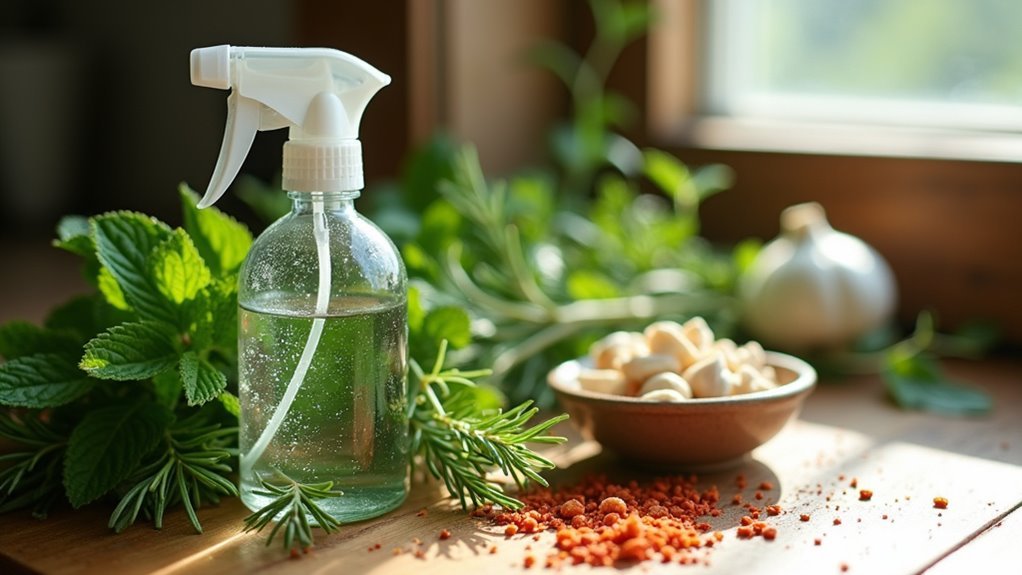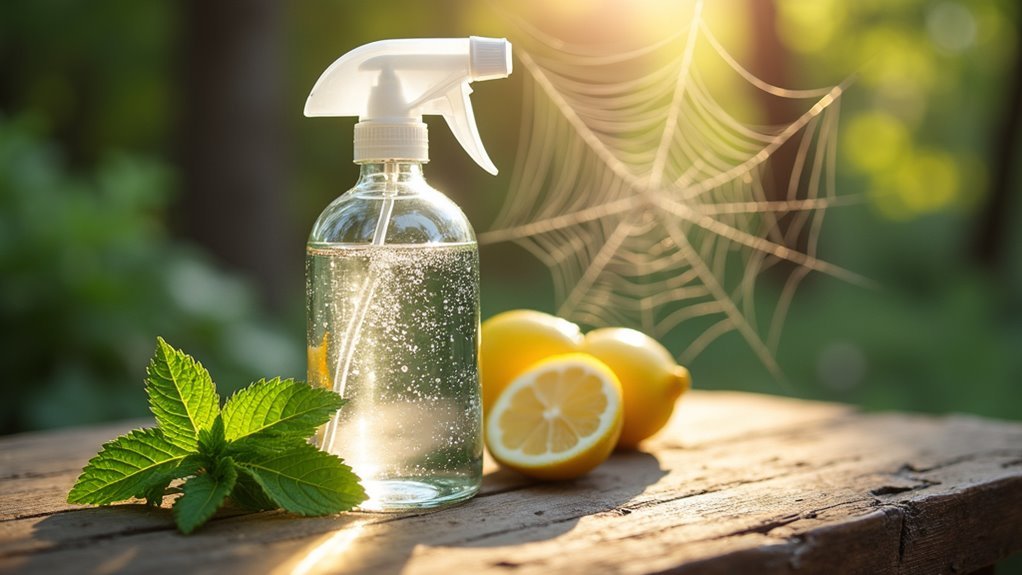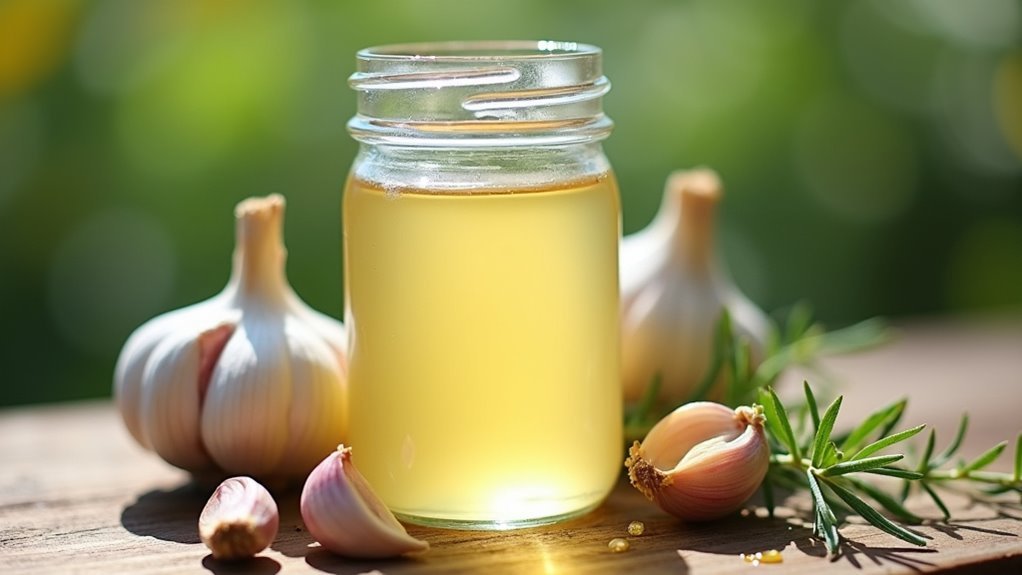You can make an effective spider barrier spray by mixing equal parts white vinegar and water, then adding one tablespoon of dish soap per two cups of mixture. For stronger repulsion, combine 5-10 drops of peppermint oil with two cups of water and dish soap. Spray generously around door frames, window sills, and corners where spiders enter. Reapply weekly during peak spider seasons for maximum effectiveness, and discover additional natural methods that’ll keep your home spider-free year-round.
Why Homemade Spider Sprays Are Effective

When spiders detect strong scents through the taste buds on their legs, they’ll quickly retreat from areas treated with homemade sprays containing essential oils like peppermint and citronella.
This natural spider repellent method works because these oils disrupt spider behavior patterns, making treated areas inhospitable. Peppermint essential oil is particularly effective due to its potent scent that overwhelms spiders’ sensitive leg receptors.
Essential oils create an overwhelming sensory barrier that disrupts spider navigation, forcing them to avoid treated areas entirely.
You’ll find these DIY solutions offer dual benefits – they kill spiders on contact while preventing future infestations.
Unlike harsh chemical pesticides, homemade sprays use non-toxic ingredients that keep your family and pets safe. The key lies in consistent application, especially during peak spider seasons, to maintain protective barriers around your home’s entry points and problem areas.
Essential Ingredients for Spider Barrier Spray
Creating an effective spider barrier spray starts with selecting the right ingredients that naturally repel these eight-legged intruders. You’ll need essential oils as your primary spider repellents, since spiders have taste buds on their legs and actively avoid strong scents.
| Ingredient | Purpose |
|---|---|
| Peppermint/Spearmint Oil | Primary repellent scent |
| Citronella Oil | Natural spider deterrent |
| White Vinegar | Repels and kills on contact |
| Dish Soap | Enhances spray adhesion |
| Diatomaceous Earth | Creates physical barrier |
Mix 5-10 drops of your chosen essential oil with 2 cups of water and a tablespoon of dish soap. You can substitute or combine vinegar with water for added potency. Diatomaceous earth provides an abrasive element that spiders won’t cross, making your barrier even more effective.
Basic Vinegar Spider Spray Recipe

One of the most effective and budget-friendly approaches involves using white vinegar as your main spider-fighting ingredient.
Creating a basic vinegar spider spray requires just three simple components: white vinegar, water, and dish soap.
Mix equal parts white vinegar and water in a container. For a small batch, combine one cup of each liquid. Add one tablespoon of dish soap for every two cups of mixture to boost the spray’s killing power against spiders.
Transfer your solution into a spray bottle for easy application. Spray directly onto spiders and their preferred hiding spots for immediate results.
The vinegar’s acidity kills spiders on contact while helping repel spiders from returning to treated areas. Reapply regularly to maintain effective spider deterrence throughout your home.
Peppermint Oil Spider Repellent Formula
For households seeking a gentler yet effective spider deterrent, peppermint oil offers an excellent natural alternative that combines pest control with a fresh, pleasant scent.
This peppermint spray creates an effective barrier that spiders avoid due to the oil’s strong aroma.
To create your spider control solution, you’ll need:
- 5-10 drops of peppermint oil
- 2 cups of water
- 1 tablespoon of dish soap
Mix these ingredients in a glass spray bottle and apply to common spider areas like windows, corners, and doorways.
Reapply monthly for maximum effectiveness.
Exercise caution around pets, especially cats and dogs, as peppermint oil can be harmful to them.
This dual-purpose solution not only repels spiders but also leaves your home smelling fresh and clean.
Garlic Extract Spider Deterrent Method

You can create an effective garlic-based spider deterrent using just a few common household ingredients. The process involves preparing a concentrated garlic infusion, then diluting it with water and dish soap for ideal application. We’ll cover the step-by-step preparation method and proper application schedule to keep spiders away from your home’s entry points.
Garlic Preparation Steps
Crush four fresh garlic cloves into a smooth paste using a garlic press or the flat side of a knife blade. This initial step creates the foundation for your potent garlic extract spider deterrent.
Once you’ve achieved a smooth consistency, transfer the paste to a container and add water for the infusion process.
Allow the garlic paste to steep in water for 24 hours to maximize its effectiveness. This extended infusion time guarantees you’ll extract the strongest compounds that spiders find repulsive.
After the infusion period, you’ll need to:
- Strain out all garlic residue from the water
- Mix the concentrate with two cups of fresh water
- Add one tablespoon of dish soap for enhanced effectiveness
This preparation method creates a concentrated solution that’s ready for application.
Application and Reapplication
Once your garlic extract spray is ready, target all potential spider entry points throughout your home.
Focus your application on doors, windows, and corners where spiders typically hide or build webs. The thorough coverage of these areas creates an effective barrier that discourages spider activity.
Spray the garlic mixture generously around these key locations, making sure you don’t miss cracks or crevices spiders might use.
You’ll notice the strongest deterrent effect immediately after application, but the potency gradually diminishes over time.
To maintain consistent protection against spider activity, reapply your garlic extract spray every two weeks.
This regular schedule makes certain the scent remains strong enough to keep spiders away from your home effectively.
Understanding How Spiders Respond to Natural Repellents
Understanding why natural repellents work against spiders starts with knowing how they perceive their world.
You’ll find it fascinating that spiders actually taste through their legs, making them incredibly sensitive to scents that can completely alter their behavior.
When you apply natural deterrents like essential oils, you’re fundamentally disrupting their sensory navigation system and making your space uninhabitable for hunting.
Spider Sensory Systems
Spiders don’t just see and feel their surroundings—they taste and smell through specialized receptors that make them incredibly sensitive to certain compounds. This sensitivity becomes your advantage when crafting a homemade natural spider deterrent.
Key aspects of spider sensory systems include:
- Taste buds on legs that detect scents and chemical compounds in their immediate environment
- Highly sensitive olfactory receptors that can pick up even minimal concentrations of essential oils
- Navigation disruption when exposed to strong scents that interfere with their hunting abilities
Understanding these sensory mechanisms helps you target spiders’ natural aversions effectively, making your barrier spray more successful at keeping them away.
Natural Deterrent Mechanisms
When you spray natural deterrents around your home, you’re triggering spiders’ built-in avoidance mechanisms that have evolved over millions of years. Your natural spider deterrent works because spiders taste through their legs, making them immediately aware when they encounter treated surfaces.
| Natural Ingredient | Spider Response |
|---|---|
| Peppermint Oil | Disrupts hunting behaviors |
| Garlic Extract | Triggers predator association |
| Citronella Oil | Creates taste barrier through legs |
| Cinnamon Oil | Interferes with habitat selection |
When you apply your homemade spider spray regularly, you’re creating an invisible barrier that spiders find genuinely unappealing. They’ll actively avoid these areas because their sensory systems detect the compounds as threatening or undesirable, forcing them to relocate elsewhere.
Best Application Techniques for Maximum Coverage
Although your homemade spider barrier spray contains effective ingredients, proper application techniques determine whether it’ll successfully repel spiders from your home.
These best application techniques guarantee maximum coverage while targeting spiders’ preferred hiding spots and entry routes.
Start by shaking your spray bottle thoroughly to combine all active ingredients evenly.
Focus on strategic locations where spiders typically enter and establish webs:
- Target entry points: Spray door frames, window sills, and room corners generously
- Use fine mist setting: Apply light, even coverage without oversaturating surfaces to prevent drip marks
- Apply to existing habitats: Treat visible cobwebs and spider hideouts directly
Reapply weekly during peak spider season to maintain an effective protective barrier that prevents new infestations.
Target Areas Where Spiders Enter Your Home
You’ll need to focus your spider barrier spray on specific entry points where these eight-legged invaders typically sneak into your home.
The most common access routes include gaps around windows and doors, foundation cracks, and areas where utilities enter your house.
Common Entry Points
Before you can effectively apply your spider barrier spray, you need to identify where these eight-legged intruders are actually getting into your home. Spiders are surprisingly resourceful when it comes to finding entry points, and they’ll exploit even the smallest openings to establish themselves inside.
The most common access routes for spiders in your house include:
- Gaps around windows and doors – These unsealed spaces provide easy passage for spiders seeking shelter.
- Foundation and wall cracks – Even tiny fissures can serve as highways for determined arachnids.
- Ventilation openings without screens – Exhaust vents and other openings offer direct indoor access.
Additionally, overhanging branches touching your home create natural bridges, while unsealed utility lines and pipes provide direct pathways inside.
Strategic Application Zones
Once you’ve identified where spiders enter your home, effective application requires targeting specific zones where your barrier spray will have maximum impact.
Focus heavily on entry points like doors and windows where spiders commonly infiltrate. Apply spray generously in room corners, along baseboards, and behind furniture where spiders establish webs and hiding spots.
Create a protective perimeter around your home by treating outdoor areas including patios, decks, and garden edges.
Don’t overlook gaps where plumbing and electrical lines enter—these often-missed spots provide easy access for spider infestation.
Pay special attention to areas that experience heavy foot traffic or cleaning, as you’ll need to reapply more frequently in these high-activity zones to maintain your barrier’s effectiveness.
How Often to Reapply Your Homemade Spray
While homemade spider sprays offer an effective natural deterrent, they require more frequent application than commercial pesticides to maintain their protective barrier.
You’ll need to reapply homemade spray weekly during peak spider seasons when house spiders are most active. However, areas with heavy infestation may require more intensive treatment.
For best results, consider these application frequencies:
- Standard maintenance: Reapply weekly during peak spider activity periods
- Heavy infestations: Apply 2-3 times per week in problem areas
- After moisture exposure: Immediately reapply following rain or cleaning
Always test your spray on inconspicuous surfaces first to prevent staining.
Safety Considerations for Pets and Children
When creating your spider spray, you’ll need to choose pet-safe ingredients since common essential oils like peppermint can be toxic to cats and dogs.
You should apply the spray using child-friendly methods, testing on small fabric areas first and keeping the solution out of reach during storage.
It’s also vital that you’re aware of which plants and ingredients pose risks to your household members, monitoring both pets and children for any adverse reactions after use.
Pet-Safe Ingredient Selection
As pet owners create homemade spider sprays, they must prioritize ingredient safety to protect their furry family members.
Pet-safe ingredient selection requires avoiding essential oils like peppermint and tea tree oil, which can be toxic to cats and dogs. Instead, you’ll want to focus on natural alternatives that effectively repel spiders without compromising your pet’s health.
Consider these safe options for your homemade spider spray:
- Vinegar and dish soap – Generally safe for pets and children while maintaining effectiveness
- Plant-based ingredients – Garlic, basil, or lavender that naturally repel spiders without toxicity
- Patch testing – Always test solutions on small areas first to prevent surface damage
Remember that homemade spider sprays require regular reapplication since their effectiveness diminishes over time, ensuring continued protection for your household.
Child-Friendly Application Methods
Beyond selecting pet-safe ingredients, you’ll need to implement child-friendly application methods that minimize exposure risks during the spray process.
Apply your homemade spider repellent when children aren’t in the immediate area, allowing surfaces to dry completely before they return. Focus on baseboards, corners, and entry points rather than areas where kids frequently play or touch.
Always test your homemade spray on inconspicuous areas first to prevent staining.
Store the solution in clearly labeled glass bottles, keeping them out of children’s reach in high cabinets or locked storage areas.
During application, guarantee proper ventilation by opening windows or using fans.
These child-friendly precautions maintain effectiveness while protecting your family’s safety throughout the spider control process.
Toxic Plant Awareness
Why might seemingly harmless plants pose unexpected risks to your furry friends and children?
Even natural ingredients in spider repellent sprays can create serious health hazards for pets and kids.
Plants like mint and lavender become toxic when consumed in large quantities, particularly affecting cats and dogs.
Peppermint oil contains compounds that trigger gastrointestinal upset and respiratory problems in animals.
You’ll need to store these products safely away from curious paws and hands.
Consider these essential safety measures:
- Research specific toxicity levels of toxic plants before using them around your household
- Keep a reference list of dangerous plants and their potential effects handy
- Monitor pets closely when applying natural repellents, watching for vomiting or diarrhea symptoms
Your vigilance protects everyone while maintaining effective pest control.
Comparing Homemade Vs Commercial Spider Products
When deciding between homemade and commercial spider sprays, you’ll find each option offers distinct advantages depending on your specific needs and situation.
| Feature | Homemade Spider Spray | Commercial Products |
|---|---|---|
| Safety | Natural ingredients safer for pets/children | May contain harmful chemicals |
| Effectiveness | Requires frequent application | Stronger, longer-lasting results |
| Cost | Budget-friendly and customizable | Fixed formulations, higher cost |
| Application | Best for indoor prevention | Designed for severe outdoor infestations |
Commercial products deliver consistent results with specific usage instructions, while homemade spider solutions offer flexibility and peace of mind. Pest control companies often recommend commercial options for serious infestations, but many homeowners successfully manage light spider problems with natural alternatives. Your choice depends on infestation severity and safety priorities.
Additional Natural Spider Prevention Methods
While sprays provide immediate protection, you can strengthen your spider defense strategy by implementing several complementary natural prevention methods throughout your home and property.
Beyond essential oils in spray form, you have access to proven techniques that create lasting barriers. Diatomaceous earth works exceptionally well when sprinkled around your home’s foundation, creating an effective pest barrier that’s completely safe for children and pets.
- Plant natural deterrents like basil and lavender around entry points for aesthetic spider control
- Maintain cleanliness through regular vacuuming of corners and cobwebs to eliminate spider habitats
- Remove harborage areas by storing woodpiles and debris away from your house exterior
These methods work synergistically with your homemade sprays, providing extensive protection that addresses both immediate threats and long-term prevention.
Troubleshooting Common Spider Spray Issues
Even with the best homemade spider spray recipe, you might encounter situations where your natural deterrent doesn’t perform as expected.
Sometimes even the most effective natural spider repellents may not deliver the results you’re hoping for initially.
If your spray isn’t working, first check your essential oil concentration—too few drops won’t provide adequate repellent properties. Always test on inconspicuous areas first, as some ingredients may stain different surfaces.
When spiders persist, increase application frequency to weekly during peak seasons. You’re likely missing key areas like entry points and common spider habitats where these pests congregate.
If spider activity increases despite treatment, your homemade spider solution needs support from other prevention methods.
Combine your spray with sealing gaps and reducing clutter to keep spiders away more effectively. This all-encompassing approach maximizes your natural deterrent’s success rate.
Maintaining a Spider-Free Environment Long-Term
Although your homemade spider spray creates an effective deterrent, you’ll need consistent prevention strategies to maintain a spider-free home year-round. Your homemade spider barrier requires weekly reapplication during peak seasons, but combining it with additional methods guarantees lasting results.
Implement these essential maintenance practices:
- Regular cleaning routine – Vacuum corners, ceilings, and dark spaces weekly to eliminate spider webs and egg sacs before they establish colonies.
- Seal entry points – Check and repair cracks around windows, doors, and walls to block spider access routes into your living spaces.
- Declutter consistently – Keep storage areas, basements, and outdoor spaces organized to eliminate potential spider habitats.
Consider planting basil and mint near doorways as natural deterrents. This thorough approach guarantees your efforts remain effective long-term.
Frequently Asked Questions
How Do You Make Homemade Spider Proofing?
You’ll mix 5-10 drops of peppermint essential oil with 2 cups water and 1 tablespoon dish soap in a spray bottle. Apply it weekly around windows, doors, and corners for effective spider deterrence.
What Is the Best Household Spray to Kill Spiders?
You’ll find the best household spray combines equal parts white vinegar and water with one tablespoon of dish soap. This mixture kills spiders on contact while disrupting their navigation abilities effectively.
Will Vinegar and Dawn Kill Spiders?
Yes, you’ll kill spiders effectively with vinegar and Dawn. Mix equal parts vinegar and water with a tablespoon of Dawn in a spray bottle. It disrupts their exoskeleton and suffocates them within minutes.
What Smell Do Spiders Hate the Most?
Spiders hate peppermint oil’s scent the most because it disrupts their sensory perception. You’ll also find they avoid citronella, lavender, and clove oils, plus vinegar’s pungent smell effectively repels them.
In Summary
You’ve now got proven spider spray recipes that’ll protect your home naturally and safely. Don’t forget to reapply your chosen formula every few weeks and combine it with regular cleaning to maximize effectiveness. Test each recipe in small areas first, and remember that consistency beats perfection when you’re maintaining your spider barrier. With these simple ingredients and methods, you’ll keep spiders away without harsh chemicals or expensive commercial products.





Leave a Reply